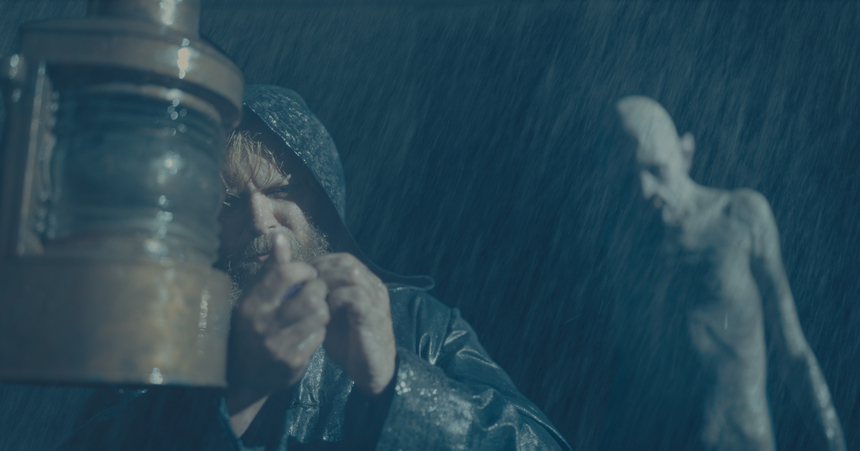THE LAST VOYAGE OF THE DEMETER Review: Dracula Sets Sail On Seas Of Blood

Inspired by a single harrowing chapter from Bram Stoker’s Dracula, André Øvredal’s The Last Voyage of the Demeter fleshes out the ill-fated sea journey from Romania to England of literature’s most terrifying vampire. What was a little less than two thousand words in the novel, a translated-from-Russian ship’s log, is now a two-hour feature film that attempts to fill in some gaps in the story and illuminate a section of the novel that has historically gotten short shrift on the big screen.
As the Demeter prepares to leave port in Bulgaria on its two-week passage to England, the ship’s captain Eliot (Liam Cunningham) and first mate Wojchek (David Dastmalchian) need to add a few hands to the crew before setting off. A last-minute departure from a deckhand wary of some of the ship’s mysterious cargo means that Clemens (Corey Hawkins), a previously rejected applicant, is now the ship’s doctor, among other things. A university educated black man is a bit of a curiosity on the ship, but he soon fits in with the rest of the crew, and soon his medical skills will come in handy.
Particularly interested in Clemens is Captain Eliot’s grandson, Toby (Woody Norman), a precocious boy of about twelve. They are soon joined by a curious castaway, a sickly woman named Anna (Aisling Franciosi), whose frail condition is not only worrying to Clemens, but belies a greater danger aboard the ship. Violence envelopes the Demeter, and soon it becomes clear that something else is on board, and it demands blood. Far from their destination, the crew must fight for their lives, held captive at sea with a horrifying monster who sees them as nothing more than sustenance for the journey. Whether any of them reach England is in question, as one by one, the beast claims them for his own.
After making a big splash among genre film fans with his first film, Trollhunter, André Øvredal made the successful jump to big time Hollywood with 2019’s excellent adaptation of the popular children’s book series, Scary Stories to Tell in the Dark. The Last Voyage of the Demeter marks his second major feature and adaptation of a popular – to say the very least – text. With Demeter, he takes a stab at a mix of monster movie and slasher, with largely positive results in both regards, though the film is not without its issues.
The lead performances from Hawkins and Cunningham are excellent, with the former managing a difficult balancing act of being both empathetic to the situation around him, but also commanding enough to engender trust among the rough and tumble crew – though it takes him a minute to get there. Cunningham matches his energy, a scruffy seafaring man, he’s also willing to listen to this newcomer as well as playing doting grandparent to a rambunctious child. The performances are uniformly solid, including Dastmalchian, who is almost unrecognizable, and suit acting icon, Javier Botet as Dracula.
Botet’s Dracula is savage, Demeter doesn’t take the romantic route pioneered by Bela Lugosi’s portrayal in the 1931 Hollywood original, this vampire owes more to Max Schreck’s Nosferatu than anything else. While he does spend a lot of time – necessarily – lurking about in the dark, the makeup design by Göran Lundström is giving just enough exposure to let the audience know how frightening he is. We may not see him until forty minutes in, but when he appears it is appropriately scary and the animalistic brutality of the kills are well worth the wait.
As much good work as the film does establishing the threat and characters, the film is not without its issues. At nearly two hours, it can be a bit of a slog. Even before Dracula appears on screen, the audience and crew are presented with the bloody remnants of his handiwork, which is fantastic and really ramps up the tension. However, once he becomes a visual presence in the film, things kind of slow down between the kills. Yes, Dracula can only kill at night, which means that after each attack the sun rises and the crew can plan for their survival for the next night, however, it just takes up too much time. What wants to be a siege feels more like a struggle to reach a conclusion, in spite of the excellent physical craft on display.
The Last Voyage of the Demeter is a mix of many different genres and elements that could be at odds with one another, but still manages to mostly come together in the end. It takes the gothic imagery mixed with violence that became the hallmark of Hammer Films’ seventies output and augments it with modern action sensibilities and quality practical effects work. Øvredal has become one of the great hopes in horror cinema, not only with the films mentioned above, but also with his similarly single-location The Autopsy of Jane Doe, to which Demeter seems like a mega-budget big brother. Not a film to rely too heavily on the oft derided jump scare, Demeter gives further evidence that Øvredal is a name you can trust, a director who understands the effectiveness of atmosphere in creating anxiety and that set up means nothing without a powerful pay off. It may be little too long for its own good, The Last Voyage of the Demeter is nevertheless a hugely enjoyable creature feature that brings fresh blood to one of cinema’s grandest villains.
Last Voyage of the Demeter
Director(s)
- André Øvredal
Writer(s)
- Bragi F. Schut
- Zak Olkewicz
- Bram Stoker
Cast
- Corey Hawkins
- Aisling Franciosi
- Liam Cunningham







